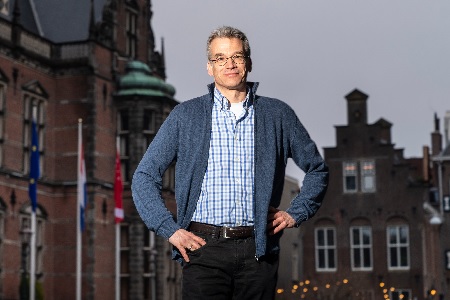Groene koolstof heeft de toekomst
De mensheid moet af van haar verslaving aan olie en gas. Maar daarvoor zijn wel nieuwe bronnen nodig voor koolwaterstoffen, de moleculen waarvan brandstof en veel materialen zijn gemaakt. Zo’n twee jaar geleden begon RUG-hoogleraar biochemie Matthias Heinemann zich af te vragen hoe Nederland een bijdrage zou kunnen leveren aan de verschuiving naar het gebruik van niet-fossiele koolstof. Hij is inmiddels lid van een klein team dat leiding geeft aan een groot samenwerkingsverband van kennisinstituten en de industrie, dat werkt aan een voorstel om een revolutie in de chemische industrie teweeg te brengen. FutureCarbonNL wil nuttige producten maken van kooldioxide uit afvalgassen en misschien zelfs uit de lucht.
Je verwacht niet zo snel een biochemicus als motor achter de vernieuwing van de chemische industrie. ‘Als ons voorstel wordt gefinancierd zal ik er zelf ook niet direct iets aan hebben’, erkent Heinemann. Zijn onderzoeksveld is de stofwisseling van micro-organismen, wat weinig of niets te maken heeft met koolstof afvang en -gebruik (Carbon Capture and Utilization), het idee achter een onderzoeksvoorstel dat 663 miljoen euro vraagt van het Nationaal Groeifonds, opgezet door de overheid om de Nederlandse economie te versterken.

Schoorstenen
De belangstelling van Heinemann voor dit project ontstond toen hij hoorde dat de EU honderden miljoenen wilde investeren in de provincie Groningen, als compensatie voor het verlies aan banen in de aardgaswinning. ‘Ik begon na te denken hoe dat geld optimaal te gebruiken zou zijn’, vertelt Heinemann. De beste manier, zo meende hij, was om een totaal nieuwe bron te gaan zoeken voor koolstof. ‘In een groene economie moet je het fossiele koolstof dat in onze alledaagse producten zit vervangen door een duurzaam alternatief. Dat lukt niet met alleen recycling en koolstof uit biomassa zou teveel concurreren met de voedselproductie.’
Een derde optie is om de koolstof te winnen uit fabrieksschoorstenen. De industrie stoot grote hoeveelheden van het broeikasgas koolstofdioxide (CO2) uit. Heinemann: ‘Het is mogelijk dit om te zetten in nuttige koolstof-houdende moleculen, door het gas te combineren met waterstof.’ Hij stelt dat Nederland in een unieke positie verkeert die het mogelijk maakt een industrie te ontwikkelen om CO2 te gebruiken als bouwsteen voor nuttige stoffen. ‘Je hebt daarvoor groene waterstof nodig, gemaakt via elektrolyse van water met groene stroom. Er zijn flink wat windparken op de Noordzee en in Noord Nederland vinden grote investeringen in waterstofproductie plaats.’

Brandstof
Als lid van het kernteam van FutureCarbonNL werkte hij aan de ontwikkeling van dit idee. ‘Mijn belangstelling is die van een gewone belastingbetaler: ik wil dat overheidsgeld goed wordt uitgegeven. In dit geval gaat dat over de enorme bedragen die in een groene economie worden geïnvesteerd.’ Anders dan de gemiddelde belastingbetaler kon Heinemann helpen zijn ideeën te realiseren, onder meer in gesprekken met de provinciale overheid, de chemische industrie en andere belanghebbenden.
Het resultaat van al die inspanningen is het onderzoeksvoorstel FutureCarbonNL, dat vraagt om 663 miljoen euro van de overheid, waar dan nog eens 767 miljoen bijkomt via investeringen van vooral het bedrijfsleven. Heinemann: ‘Wij willen de technologie ontwikkelen voor het afvangen van koolstof en het omzetten ervan in nieuwe moleculen.’ Een eerste generatie van die technologie bestaat al. ‘Wij willen de tweede en derde generatie hiervan ontwikkelen. Nederland heeft een sterke chemische industrie, relatief veel groene stroom en uitstekende wetenschappers in chemische onderzoeksinstituten.’ In de toekomst zou het met die nieuwe technologieën mogelijk kunnen worden om kooldioxide uit de lucht te halen en daar groene brandstof van te maken, bijvoorbeeld voor vliegtuigen, maar ook nieuwe materialen en zelfs diervoeding.

Competitie
De Nederlandse chemische industrie, verenigd in de VNCI, is deel van het consortium achter dit voorstel, net als universiteiten, onderzoeksinstituten, groene startups, grote bedrijven en overheidsinstanties. ‘Als we slagen zal dat enorm goed zijn voor de economie en het milieu – in Nederland, maar ook in de wereld.’ Wanneer het voorstel van FutureCarbonNL groen licht krijgt, zal de verdeling van het geld gaan via een open competitie. ‘Geen van de partners in de aanvraag krijgt gegarandeerd geld. Ik houd er niet van wanneer de initiatiefnemers automatisch een deel van de koek krijgen. Opnieuw, als belastingbetaler wil ik dat het geld naar de best mogelijk onderzoeksvoorstellen gaat.’
Er vindt inmiddels al onderzoek plaats in de lijn van FutureCarbonNL, voorbeelden zijn het werk van Sandy Schmidt en Jingxiu Xie, die onder meer eiwitten en brandstof maken uit kooldioxide. De aanvraag van het programma heeft de eerste twee hordes genomen en wordt op 3 februari officieel ingediend. Ergens deze zomer volgt het eindoordeel. Heinemann: ‘De competitie is moordend. Maar we hebben hard gewerkt aan ons voorstel en naar mijn idee hebben we een sterk en overtuigend programma.’
Zie ook de FutureCarbonNL website.
Meer nieuws
-
19 december 2025
Mariano Méndez ontvangt Argentijnse RAÍCES-prijs
-
18 december 2025
Waarom innoveren, en voor wie?
-
17 december 2025
Ben Feringa wint Feynmanprijs
